As responsible travelers evolve, so do the stories we share.
This article is part of our living archive — trusted content we continue to care for.
First published on February 15, 2025 • Last updated on February 15, 2025.
The Quito Metro is a fast, affordable, and efficient way to get around Ecuador’s capital. As one of the newest public transportation systems in the Americas, it comes with a slight learning curve—especially for tourists. We checked it out on our last trip to Quito, riding it several times so that we could tell you what to look out for.
While we recommend reading the entire article, some of you are here for quick answers. Here are some links to help you out!
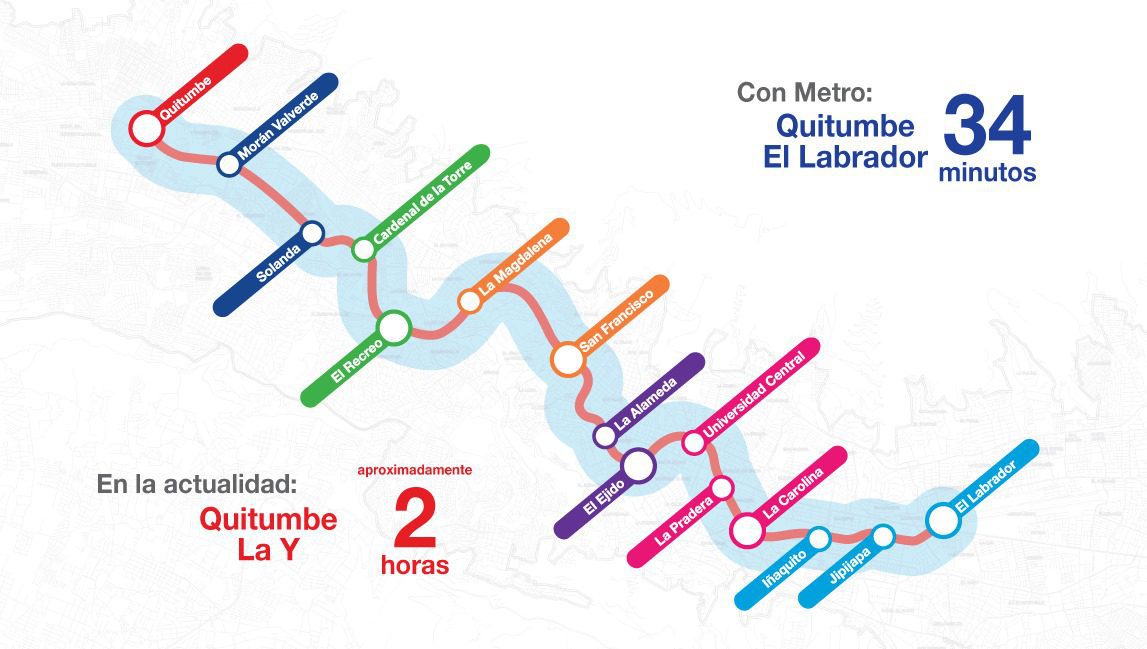
Where to Find the Metro in Quito
Quito’s Metro runs the spine of the city from El Labrador (north) to Quitumbe (south). Most tourists use the northern stops from Jipijapa (near Parque Bicentenario) to San Francisco (Historic Center).
Knowing the name of the metro stations closest to you is half the battle. After Estación Jipijapa comes Estación Iñaquito, close to the Quicentro Mall, the Iñaquito Market, and great access to the Parque Carolina’s sports fields. Then comes Estación Carolina on the corner of Eloy Alfaro and Republica, closer to the Botanical Garden and attractions in the center and southern end of the park. Estación La Pradera is barely a block and a half away, a tad closer to the Mariscal neighborhood but hardly worth the bother unless your hotel is nearby. Estación Universidad Central is great for easy access to the university grounds and the Santa Clara market. Next comes Estación Ejido, the closest station to the park of the same name, the Casa de la Cultura and its wonderful museum, and the Mariscal Artisan’s Market. Estación Alameda is located at another park and is downhill from the iconic Basilica del Voto Nacional. And the last on our list for this article is Estación San Francisco, where you will arrive in the Quito’s cobblestoned Historic Center, right on the San Francisco plaza with its imposing colonial church, the stately Casa Gangotena hotel, and Capilla de Cantuña.
Where Are the Metro Signs?
Unlike metros in cities like New York or Paris, Quito’s Metro entrances aren’t always obvious. In fact, finding the entrance can be one of the trickiest parts of your journey—especially if you’re new to the city. They have a way of blending in unless you’re walking right towards them. Worse, there are few directional signs leading you to the entrances. It’s best to ask the concierge at your hotel or apartment rental. But if you hate to ask questions, look no further than your phone.
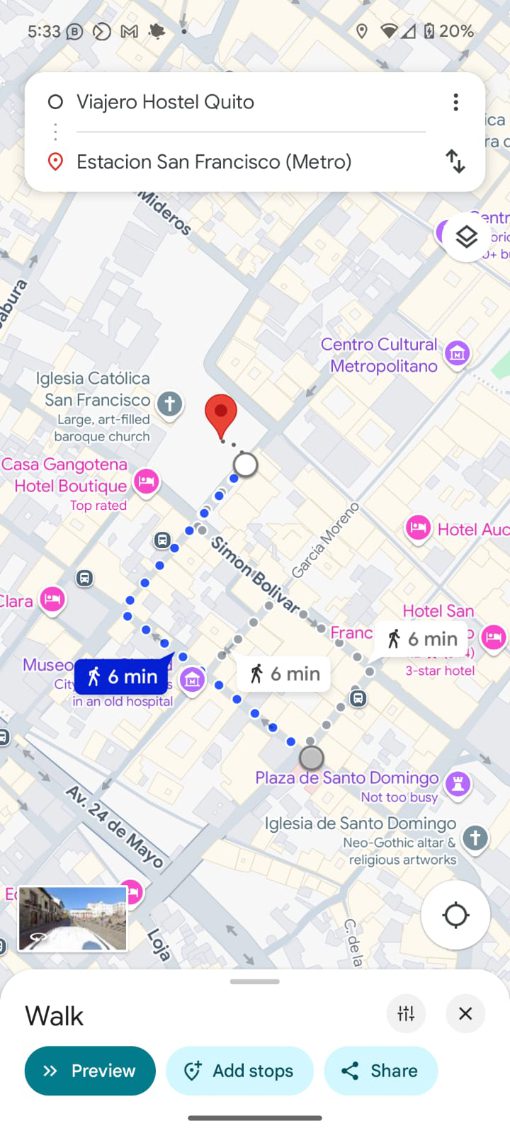
Using Google Maps to Find Your Way
Google Maps is a great tool for planning walking routes in Quito. Simply use the word “estación” and you’re likelly to pull up the closest Metro station to you. However, we don’t recommend using your phone openly on the street. Petty theft is a concern in busy areas, especially in the well-touristed areas. Instead:
- Plan your route before heading out. Search for the name of the station and you’ll get great walking directions.
- While outside, take quick glances if you need to, checking the area around you first for anyone especially interested in what you are doing.
- Memorize key landmarks near the station you’re heading to.
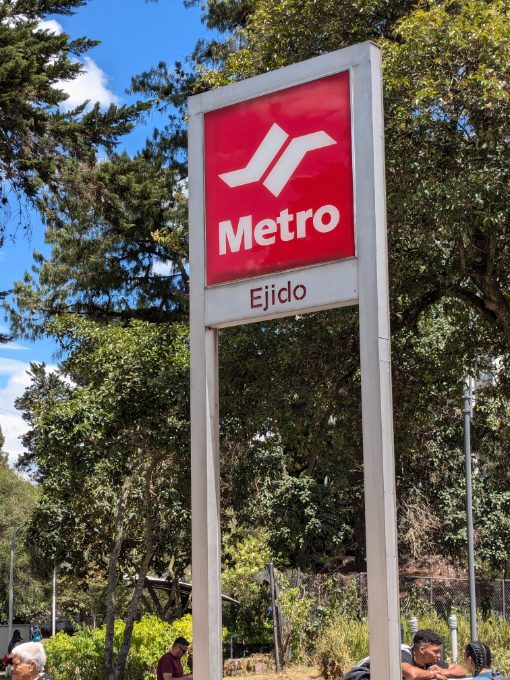
Look for the Red Signs
Distinctive red signs with white lettering and a swooping track logo mark the entrances to Metro stations. The signs aren’t huge, so keep your eyes peeled, especially if you’re walking through busy areas where they can easily blend into the urban landscape.
We wish that there were more directional signs leading you towards these places. Hopefully, the city will add those over time.
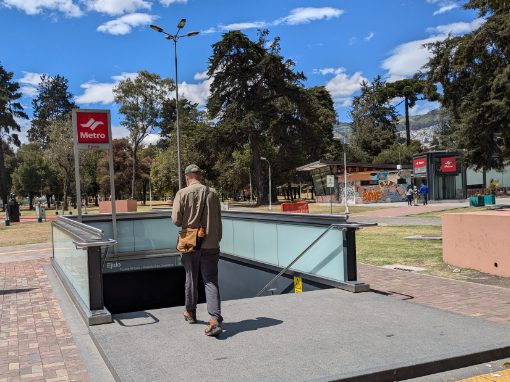
Pedestrian Entrances: Stairs & Elevators
Once you spot the sign, figure out which entrance you are at. The Metro staff asks that only people who need the elevators use them. All others should use the stairs. The two entrances are usually within visual distance of each other.
Buying Tickets: What You Need to Know
So, you’ve made it to the station. Now you need to buy a ticket. Machines and ticket counters are inside on the mezzanine level, not near the main entrance.
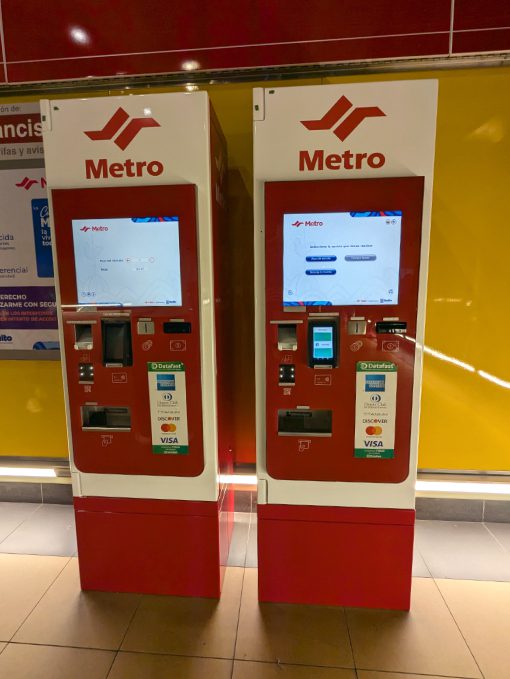
Bring Exact Change
A ride costs just $0.45. If using a machine to make your purchase, you’ll need exact change. While machines accept debit cards, swiping for such a small amount feels makes little sense.
Pro Tip: Its good to know in advance that these machines are also called ATMs… but you cannot use them to remove money from the bank.
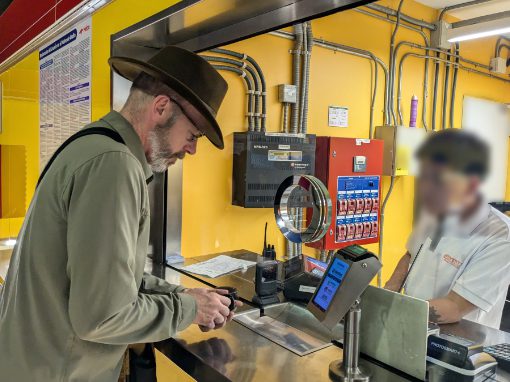
If you don’t have change…
You can buy your ticket at the ticket counter (taquilla). This is the most popular option among Ecuadorians. You can get change here, but be prepared for long lines on weekends and around rush hour—we waited 20 minutes or so at Estación San Francisco before realizing there were machines with no lines further inside.
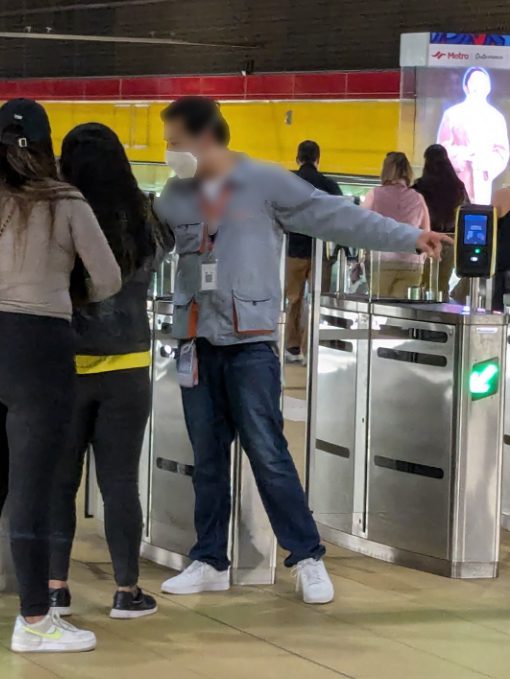
Specify your Return Station for Round Trips
If buying round-trip tickets we recommend using the ticket counter, not the machine so that you can ask for return tickets. They will want to know where you will be returning from to code the ticket correctly. We bought return tickets at the machine in Estación Carolina to go to Estación San Francisco. But they didn’t work when we decided to return using Estación Alameda—a frustrating discovery after a long day exploring! If unsure of your return plans, buy one-way tickets to stay flexible.
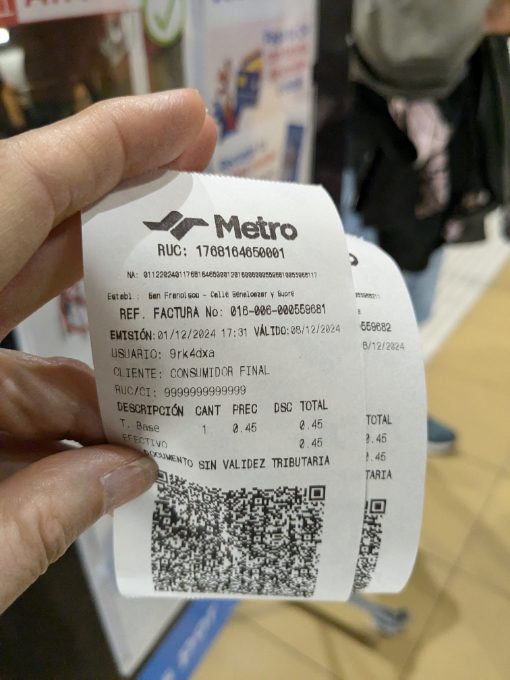
The Ticket is Flimsy
You’ll receive a white receipt with a scan code. It’s pretty flimsy so if you buy a return ticket, stick it in a safe place in your wallet rather than in a pocket where it might crumple up.
Pro Tip: You might notice in the image that the ticket is valid for one week after purchase. We recommend buying in advance for days when you expect large crowds, like Good Friday. Just confirm with the salesperson your start and stop points for each ticket.
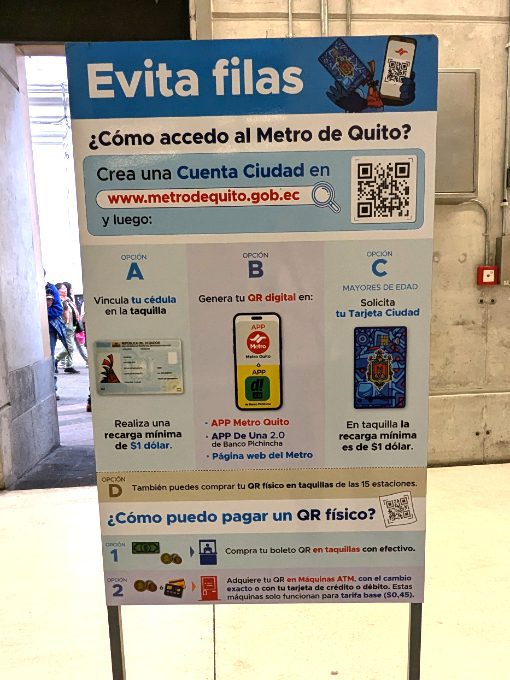
Tempted to Skip the Lines?
You might notice a sign advertising three ways to skip the line: cedula, app, or city card.
The first option is for Ecuadorians or others with an official Ecuadorian ID card, aka a cedula. Most tourists won’t have one.
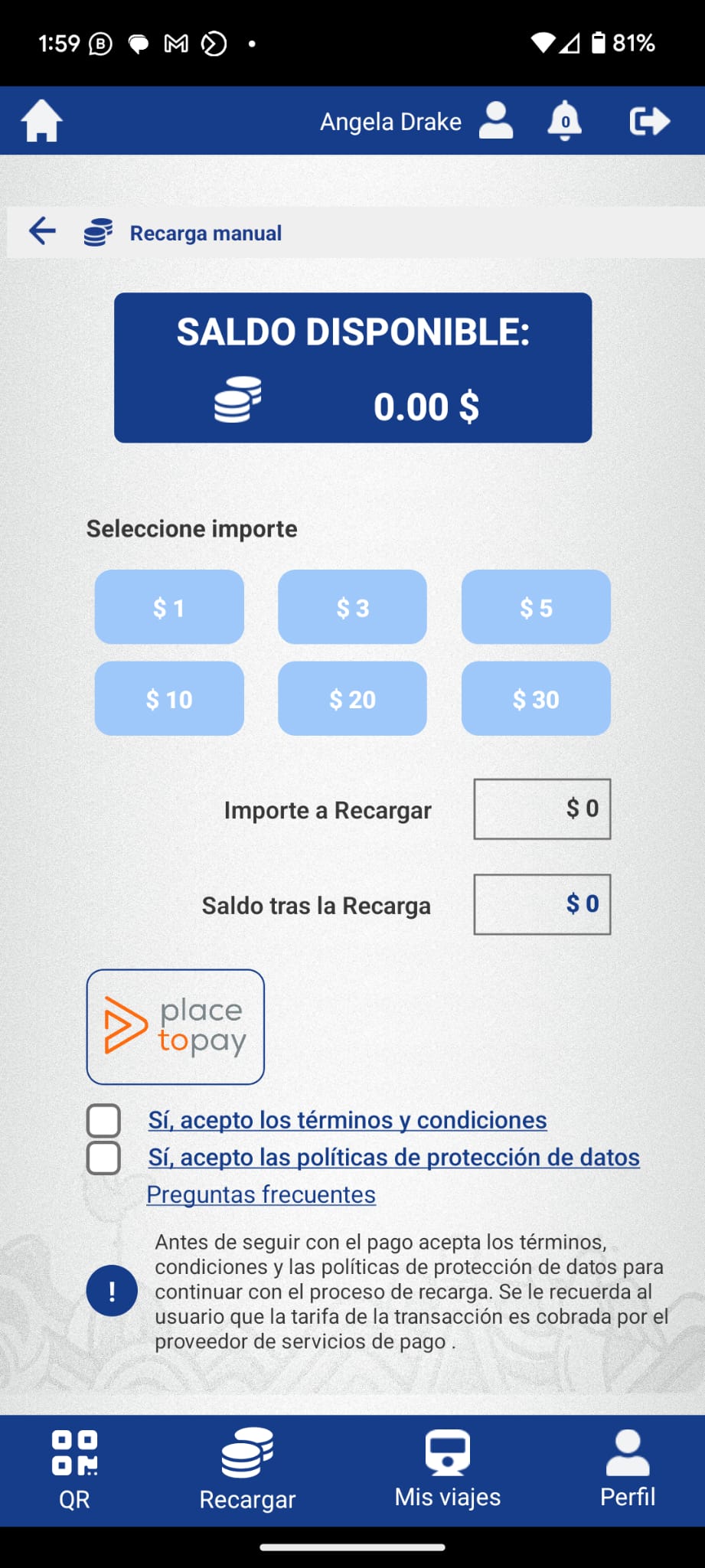
Metro Quito App
The second option is the official Metro de Quito app. I loaded it to my phone — it’s clunky, poorly reviewed (2.7 stars), asked for my passport number, and a credit or debit card. If you decide to use this app, we recommend using a credit card as it won’t be tied to a bank account. Also, you may want to set this up before leaving the country as many banks in the US will likely flag this as a questionable purchase the first time you attempt to add funds.
Personally, we are skipping the app for now. Buying tickets on the fly at the Metro comes with minimal bother and the chances of having a credit card hacked in this system seem higher than our risk assessment allows for.
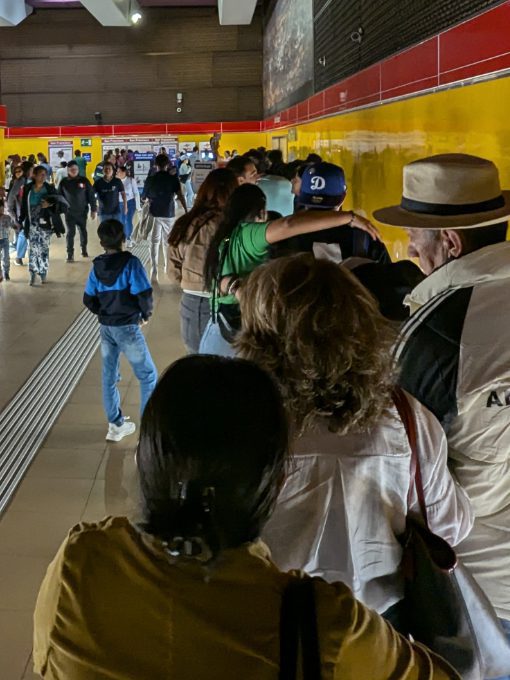
Senior Citizen Discount
The third option is for senior citizens. You might be a tourist who happens to be a senior citizen – but at these cheap ticket prices, we don’t think the catch is worth the chase.
In the end, our recommendation for skipping the link is to walk past the ticket counter line and see if a machine happens to be open instead.
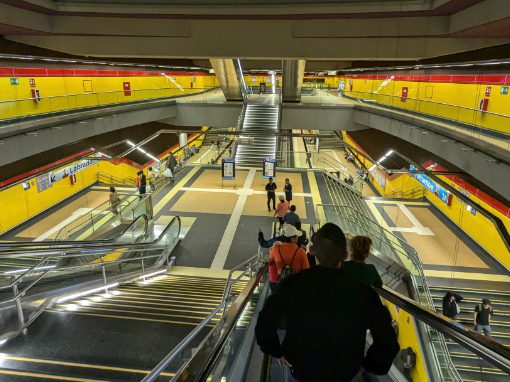
The Three Levels of Every Station
Every station has a similar design, including three basic areas:
- Vestibule: Buy tickets and enter through the gates.
- Mezzanine: Choose your direction (after scanning your ticket).
- Track Level: Where you board the train. You’ll also fine station names on the walls and screen displays with arrival times and safety warnings.
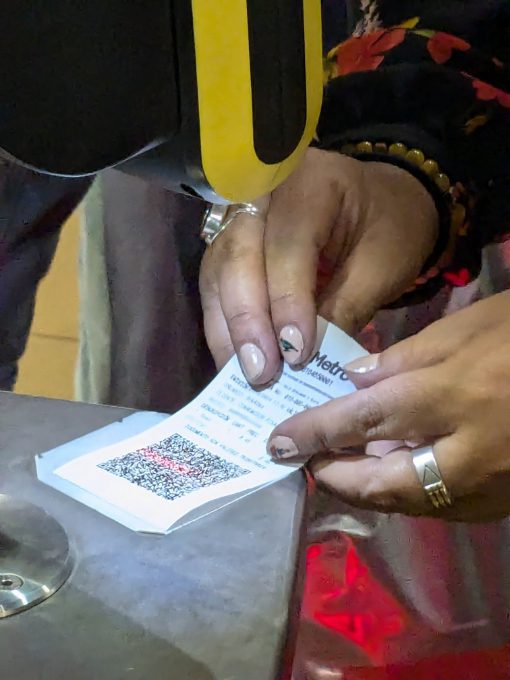
Scanning Your Ticket
Look for gates with green arrows (a red X means exit-only). Hold your ticket under the scanner. Voila! It should open and allow you to gain access.
Pro Tip: It might take a couple of tries—don’t stress! Staff are nearby if you need help.
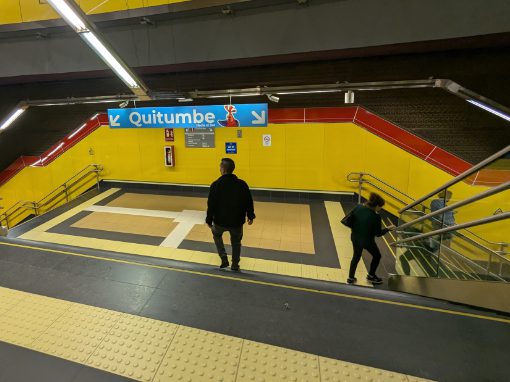
Keep to the Right
On stairs and walkways and riding down escalators, it is highly recommended to keep to the right. This allows for an easy flow and prevents human traffic jams.
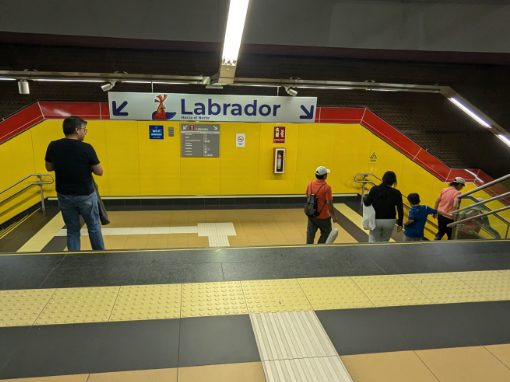
Know YOur Direction: Labrador or Quitumbe?
Instead of “northbound” or “southbound,” signs indicate terminal stations:
- Labrador (north)
- Quitumbe (south)
Even if your Spanish is basic, knowing these names will keep you on track.
Boarding and On the Train
If you’ve ridden a subway anywhere in the world, Quito’s Metro will not offer many surprises. But there may be some things that you didn’t expect.

Basic Metro Etiquette
Like subways everywhere, a few basic rules go a long way to preventing chaos.
Listen to local staff, especially when they walk up to you to explain how to use the system.
Other important rules:
- Let people exit trains before you enter.
- Give priority seating to those in need.
- Stand behind the yellow line until trains arrive
- No food or drink in the Metro stations or trains
If you are in a wheelchair or have your bicycle, look for those icons on some train car doors. These icons will guide you to the best and most ample space for your wheels!
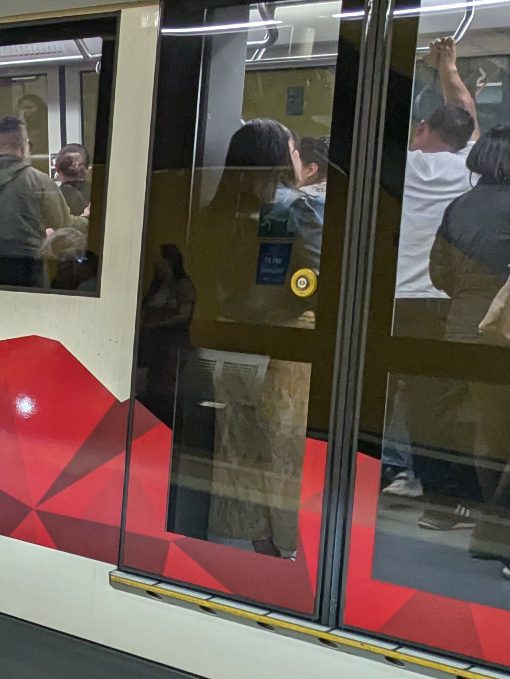
Train Cars have buttons on the doors
While we never had to press one to gain entrance, doors have a yellow and white button to press. If you’re standing in front of a door that isn’t opening, likely because no one is exiting, then be prepared to press the button.
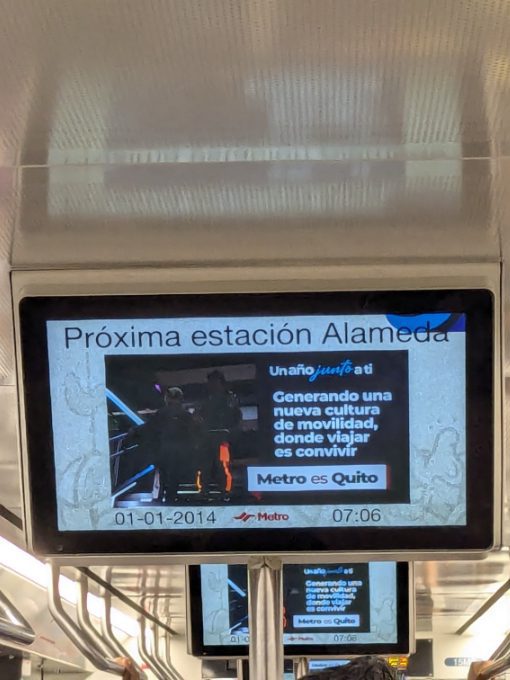
Watch the Screens
While there are announcements for each station, it can be hard to understand the Spanish, even for a native speaker. Keep apprised of the next destination by looking at the screens. It’s no fun missing your station.
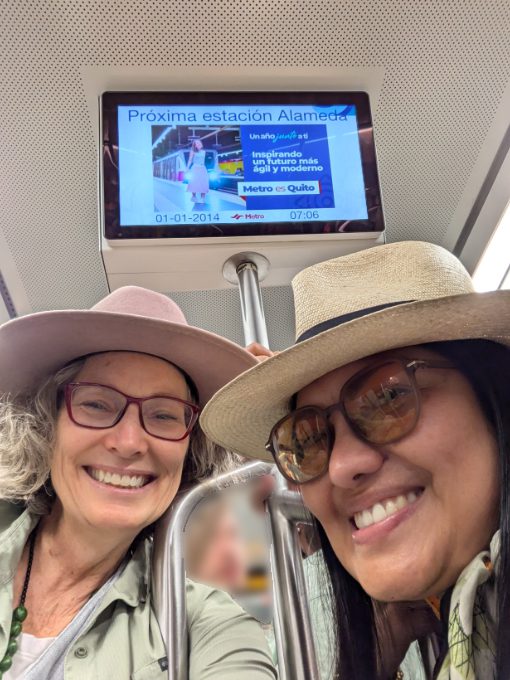
Expect Curious Stares
Gringos like me and my husband stand out on the Metro. Don’t be surprised if people stare—it’s more curiosity than anything else. A friendly smile often gets one in return!
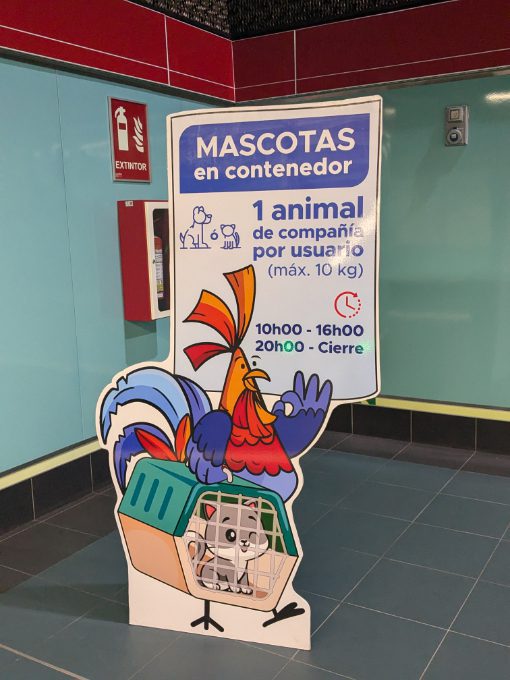
What You Can (and Can’t) Bring
Allowed:
- Small pets: well-behaved pets in a pet carrier are permitted except during rush-hour.
- Bicycles: Permitted in designated areas—look for icons on train doors.
- Medical equipment & support animals: Allowed at all times.
Not Allowed:
- Large suitcases or bulky items over 60x60x60 cm.
- Skateboards, scooters, or rollerblades (carrying them is fine, you just can’t be using or wearing them).
- Food, drinks, or alcohol inside stations or trains.
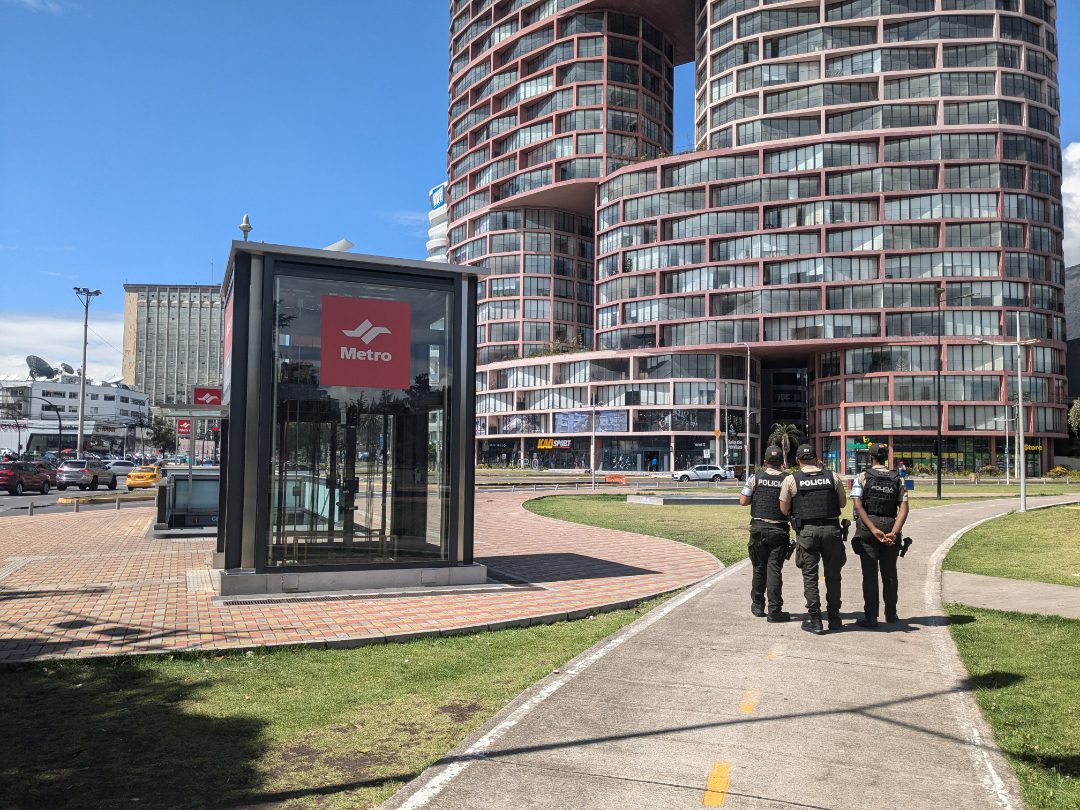
Last But Not Least – Safety and Comfort
A few final tips.
Don’t bundle up – Unfortunately, Quito’s Metro is not well-ventilated. Once you get on the train, you will find stuffy conditions with no open windows, no air conditioning, and, especially during rush hour, very warm conditions. Plan accordingly, especially for those cold days in Quito. You might want to dress in layers.
Stay Safe and Street Smart – While we felt very safe, even in crowded conditions, basic precautions are key. We noticed that most Quiteños also followed these rules:
- No phones in pockets—keep them secured.
- Crossbody bags worn in front.
- Backpacks? Swing them to your chest, especially when it’s busy.
- Expensive electronics and cameras? Keep them out of sight.
If you would like a few more safety tips for big cities, check out our article, Touring Safely in Quito.
That’s it… our Gringo’s Guide to the Quito Metro. If you have a tip to add, please let us know in the comments below. Your experience could make the difference for a fellow traveler!

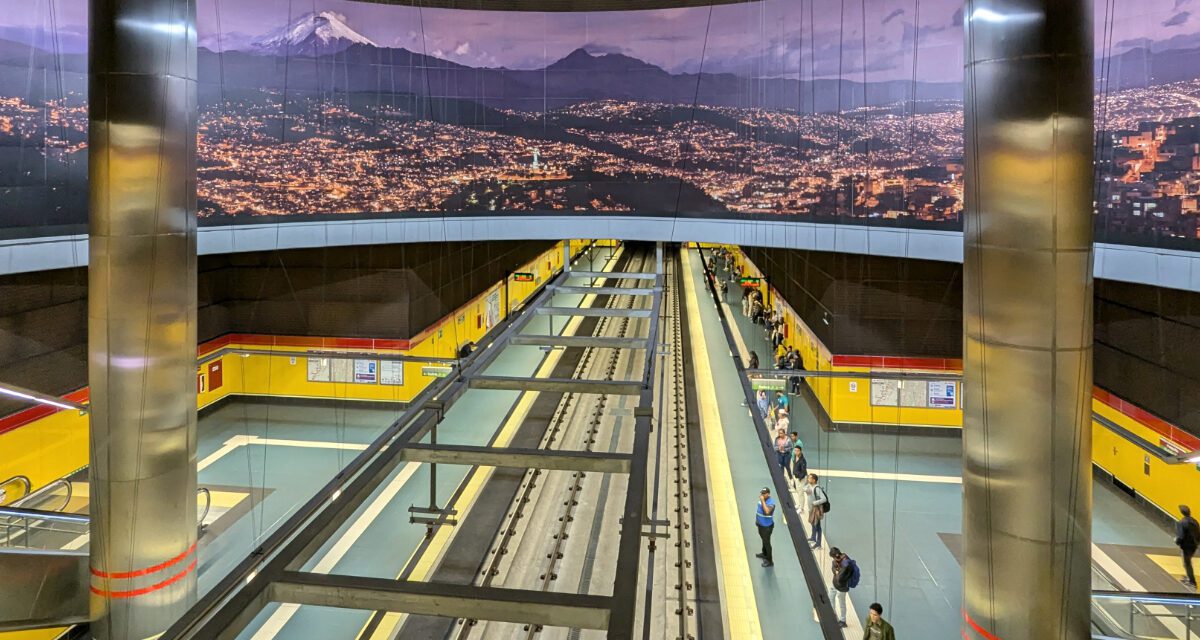
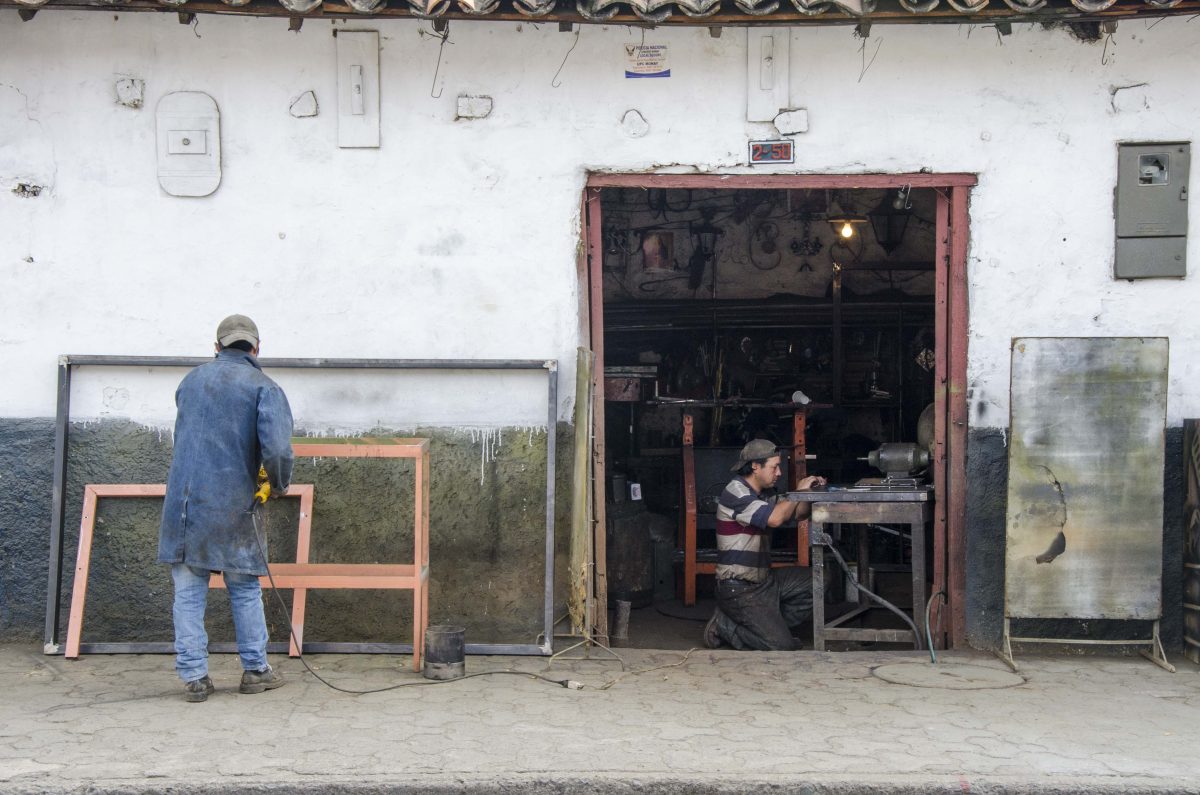
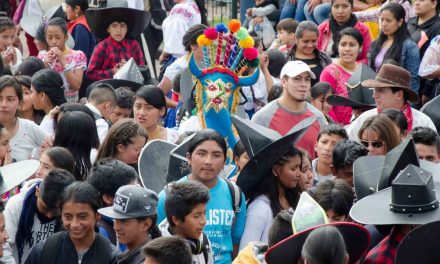
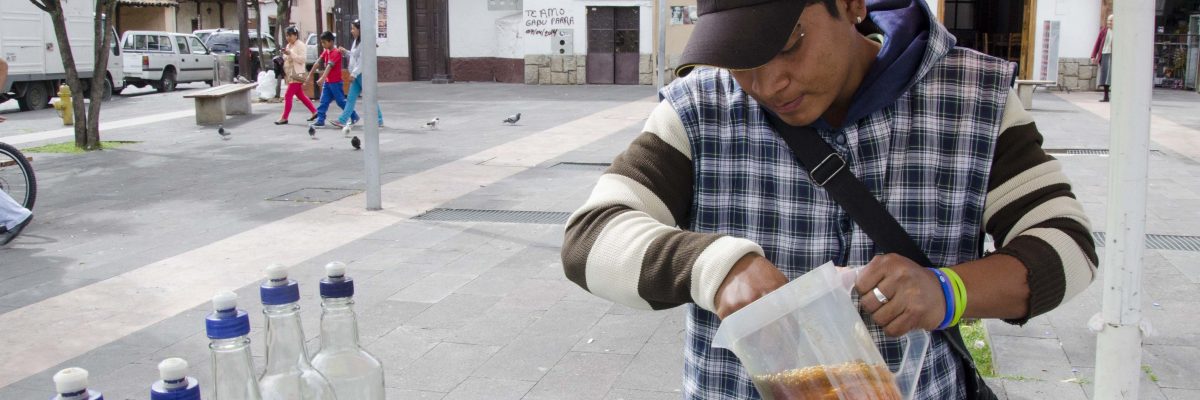
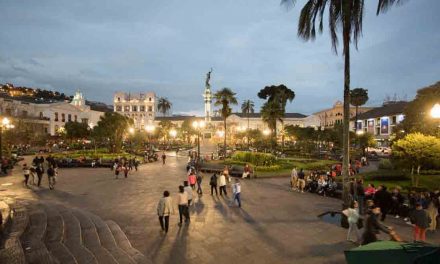

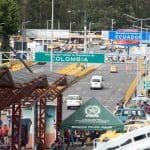














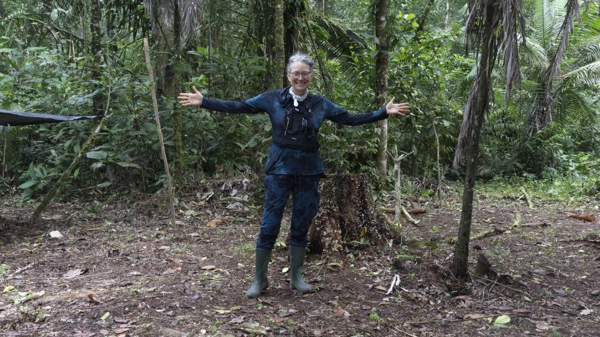
What a wonderful article – thank you. I love using public transportation everywhere I go and plan to try this out next week when I am in Quito
I am very grateful that you left a comment, Sanjiv, and very glad that you find the article helpful! Happy travels in Quito. Enjoy your trip!
Thanks very much for the comprehensive and detailed guidance! Brilliant! Looking forward to my upcoming trip – was there last a very long time ago prior to any metro system.
Hey Mike, thanks for leaving a comment! I hope you enjoy the ease of using the Metro as much as we did. It’s far better than taking a taxi across town! Have a great trip!